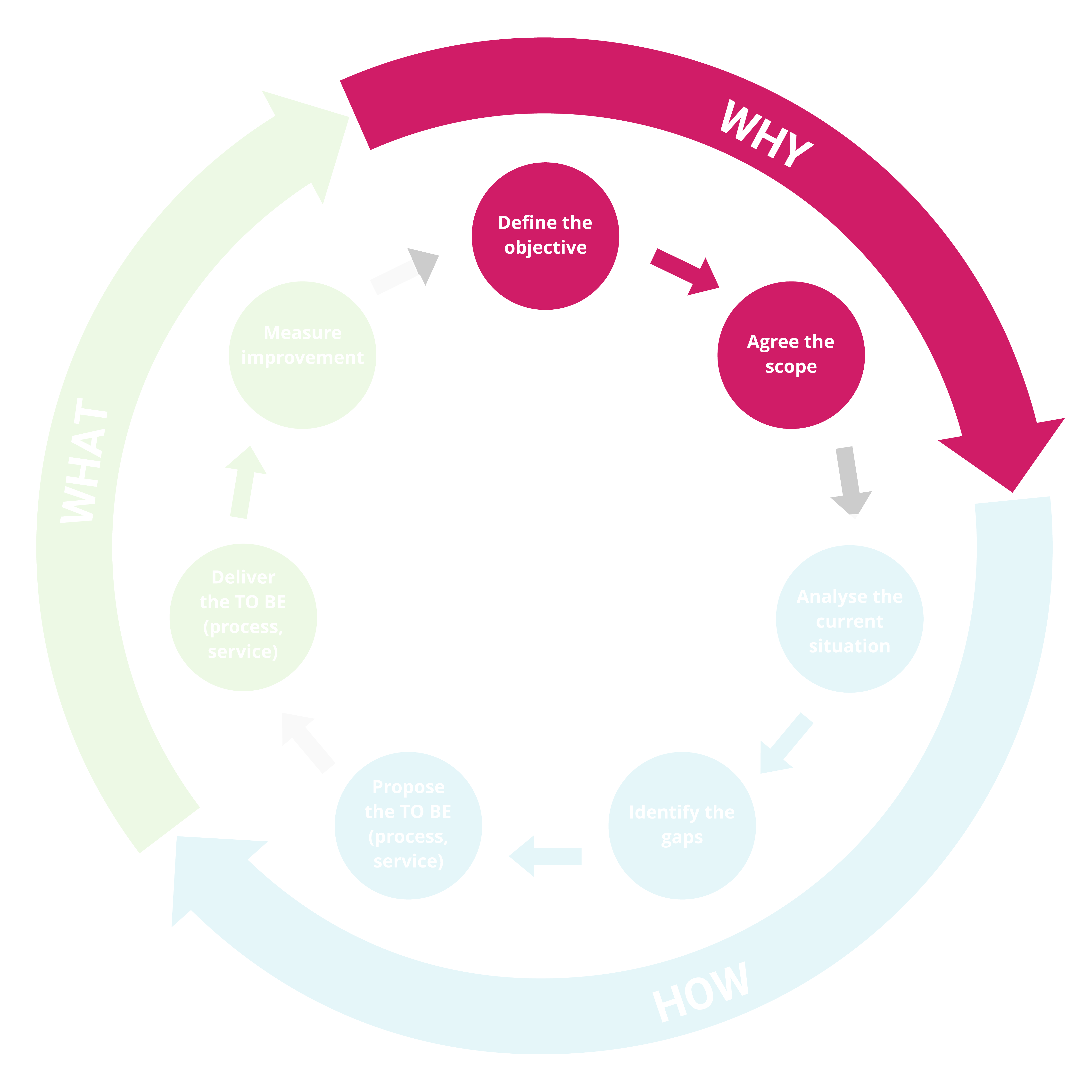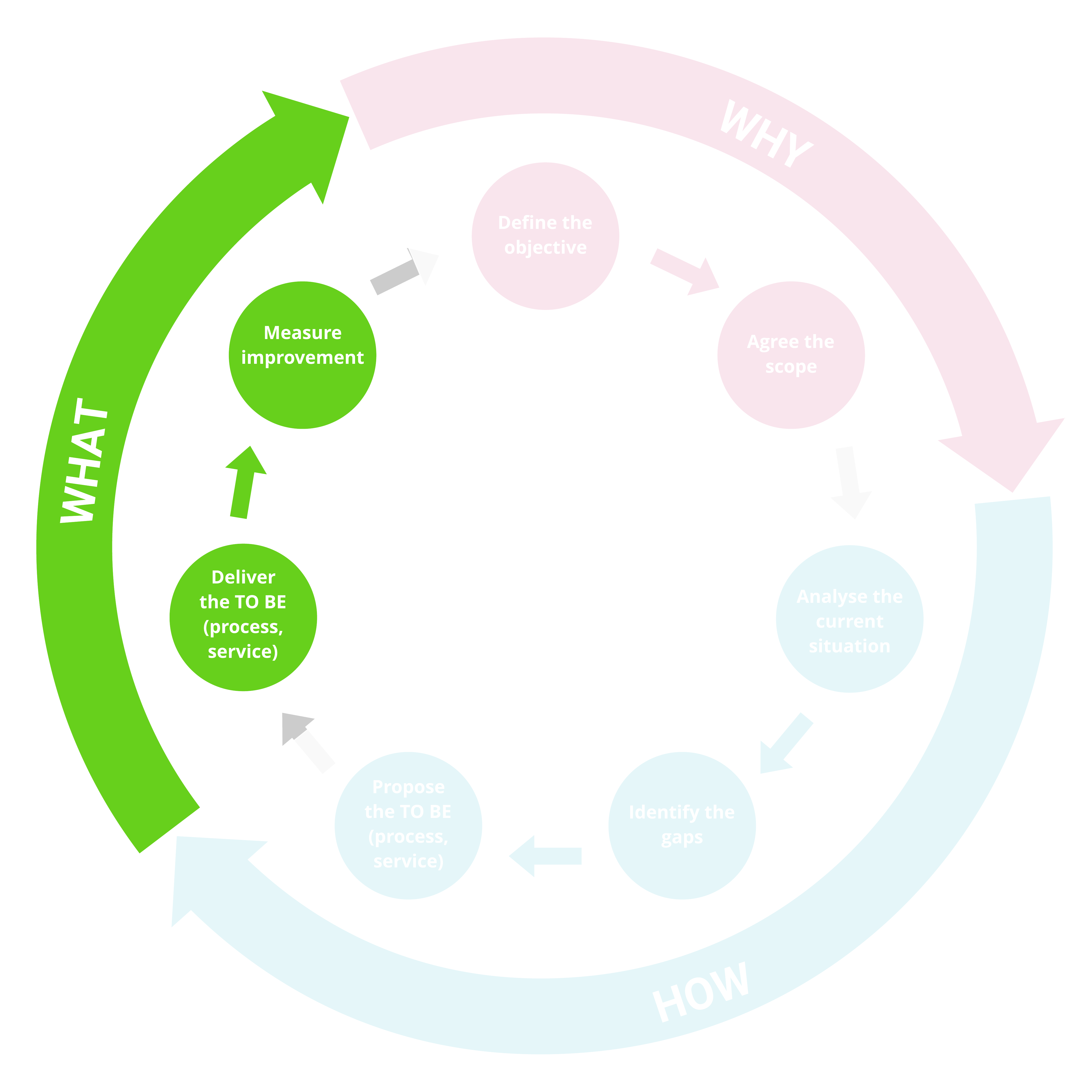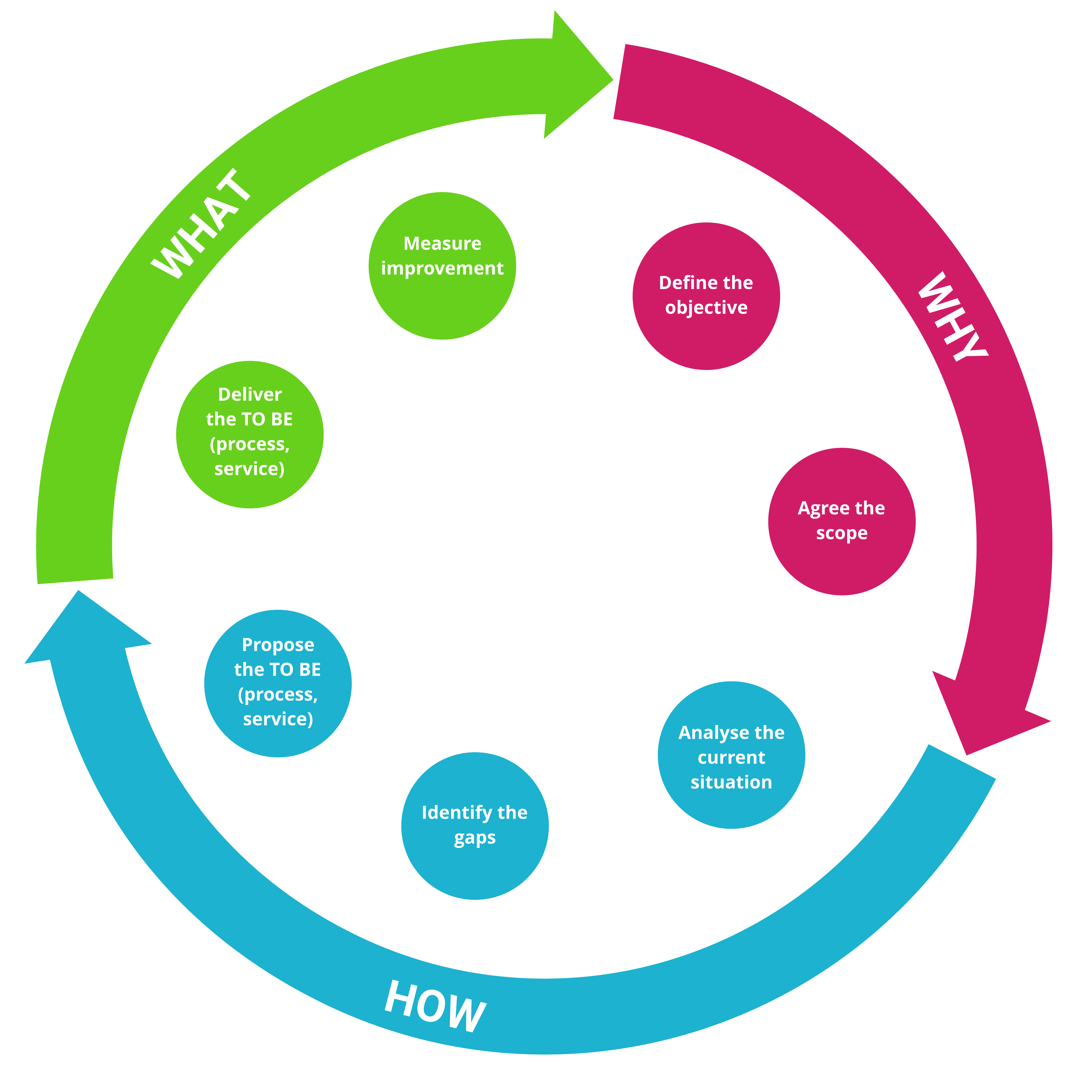We have developed this Change compass visualisation as a practical tool to support individuals and teams navigating organisational change. It describes a structured process for planning, managing and sustaining successful change initiatives.
Turning insight into impact
Introducing the change compass
The diagram reflects the continuous and cyclical nature of change, and that improvement is an ongoing endeavour.
The three outer segments represent the essential dimensions of change and their interdependencies WHY, HOW and WHAT.
- WHY – The cycle begins by defining the objective and agreeing the scope before transitioning into the HOW and WHAT
- HOW – Analysing the current situation, identifying key gaps and designing the future state
- WHAT – Focuses on delivering the proposed changes and measuring improvements to ensure that benefits are being realised
- … the cycle can then repeat, enabling the organisation to continuously improve
This tool can be used in different organisational contexts, and we’ve seen it bring clarity and momentum to change efforts.
Below is a further description of each of the segments used in the diagram (each dimension to change) alongside questions to consider, and examples of business analysis techniques that could be applied at each phase.
WHY
Strategic purpose

Define the objective and agree the scope
The importance of a clear, shared problem statement cannot be overstated, it acts as a beacon, aligning diverse teams and guiding decision-making with intent and focus.
Too often, teams are asked to reduce costs or boost efficiency without a defined target or measurable goal. Vague objectives risk misalignment, inefficiency, and frustration.
A strong problem statement makes explicit what is needed, and describes why it matters, inviting sharper thinking and meaningful change.
To craft an effective problem statement, consider the following
- What is driving the change, and why now?
- What is the deadline or timeline for implementation?
- Are there specific targets or indicators for improvement? Be specific.
- What capabilities or constraints must be on or off the table? Why?
- What other change efforts or transitional factors are in play?
- Is there a clear, actionable communications plan?
- Which stakeholders need to understand the objective and why?
Examples and related articles
HOW
Understanding the now, and shaping the next

Once the problem statement is clearly defined and the scope understood, we can begin the practical work of shaping the transformation. This phase offers a unique opportunity to both zoom-in, and zoom-out across an organisation’s activities, with each perspective having the potential to provide valuable insight. The tabs and lists on the right describe some of the techniques we use.
Analysing the current situation
True “greenfield” scenarios are rare, so understanding and analysing and the current situation is crucial to identify gaps, and define a future state that meets the organisation’s objectives.
Effective analysis balances detail with big-picture thinking and combines qualitative and quantitative methods. We typically begin by reviewing procedures, service levels, contracts, data dictionaries, and technical documentation to understand how the organisation operates and to ensure stakeholder engagement is informed and respectful from the start.
Business process participants very often have strong insight into their own activities, but may not be aware of the value these provide into the wider context.
We’ve heard comments such as “We do X, Y, Z because it is used by another team…”, only to discover later that the receiving team no longer require it, or it would be best provided in a different form.
This underscores the importance of understanding the value stream. Teams can sometimes work like they’re posting letters through a letterbox, focused only on delivering their outputs, with limited visibility of who’s receiving them and why. It’s only when we can step back and zoom out (a process often facilitated by value stream and high-level process mapping) that the full picture becomes clear, revealing opportunities where improvements can be made by optimising the flow of value.
We nearly always use a capture log through this phase, making sure to log information, opportunities and pain points identified on the journey. This capture log becomes a bible of information, and because of the way it is structured enables us to reference other sources, quickly slice/dice and visualise analysis themes.
Identify the gaps
With the objectives and current state well understood, we can begin identifying and quantifying the gaps. What may feel like a significant and insurmountable issue for one stakeholder might be a quick win for another. A consistent approach to scoring and categorising these gaps allows for clear communication and effective visualisation.
Done right, the insights on these gaps can be tailored for different audiences, from senior leaders to individual contributors.
Propose the TO BE (process, service)
Designing the future state with intention is critical. We typically anchor the TO BE around product objectives or optimised business processes, ensuring that technology decisions and operating models are driven by these needs, not the other way around.
Techniques we use regularly include
- Reviewing documentation
- Maintaining a structured capture log for flexible analysis
- Categorising insights by data concept, process, business unit, or function
- Distinguishing between different types of observations:
- Pain points
- Opportunities
- Open questions
- Conducting efficient stakeholder interviews
- Creating and annotating:
- Business activity models
- Value streams
- Business process diagrams
- Data concept maps and system lineages
- Functional overview diagrams
- Visualisations of moments of stability/disruption
- Assigning consistent impact scoring to pain points and opportunities
- Producing heat-maps to highlight items
- Value stream mapping
- Annotating value streams, business activity and process diagrams to reflect current challenges and opportunities
- Initial business planning
- Organisational design principles
- Designing future-state business processes
- Creating evaluation criteria and selection matrices
- Using visual tools to support complex decision-making
- Producing high-level architecture designs
- Defining sustainable and appropriate operating models
- Creating collateral to communicate new products or services
Examples and related articles
A repeatable approach to compare alternatives through visualisation
service design
WHAT
Delivery and impact
The WHAT segment of the Change Compass takes centre stage in bringing change initiatives to life. It’s here that the foundations laid in earlier stages truly prove their value, as they are meticulously translated into an organisational reality.
This critical phase is responsible for implementing service redesigns and, importantly, for diligently delivering and measuring the benefits that the change was intended to achieve.

Delivering the TO BE: From blueprint to reality
This stage begins by using the blueprint as a foundation for business planning. We work closely with stakeholders to determine which elements of the future state will move forward into implementation. This involves mapping requirements and design decisions into financial models and delivery roadmaps, ensuring that the cost and revenue implications are fully understood across the planning cycle.
We place strong emphasis on traceability by linking each decision back to original user needs, so there is a clear audit trail for why specific requirements were included, adapted, or deferred.
Our support continues into delivery. We can provide project management services to assist with both technology implementation and the operational changes required to embed new services. We have supported developing updated role descriptions, defining training needs and communication activities, and helping manage the change on the ground. With strong service excellence credentials, we also guide the design of underpinning service management processes, from incident and problem management to service measurement and continuous improvement. Our goal is not just to stand up a new system or process, but to help our customers ensure it performs, evolves, and delivers measurable value.
Techniques we use regularly include
- Incident and problem management processes
- Service measurement and continuous improvement
- Project management services
- Final business planning
- Governance and accountability structures
- Benefits realisation
- Identifying awareness, knowledge and capability needs
- Transition execution
- Designing operating models, working agreements and support structures
- Designing learning and training plans
- Assessing operational readiness, including wargaming
Examples and related articles
Contact the Peak Signal team for more information, or read more of our case studies here.


